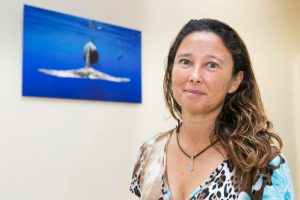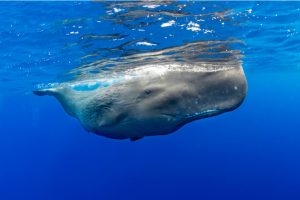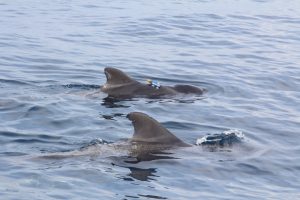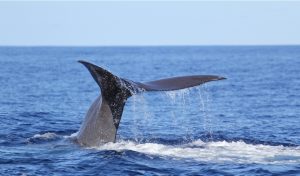Contributing to the conservation of whales, dolphins, porpoises and the marine environment is the laudable and important aim of the research carried out by Natacha Aguilar de Soto (Cartagena, Murcia, 1970). This marine biologist has been a research scientist at the Canary Islands Oceanographic Centre (IEO/CSIC) in Tenerife, Spain, since 2023, coming from the University of La Laguna, also in Tenerife, where she previously worked. Although she was born in Cartagena, this expert in cetacean ecology and behaviour has never lived there, which is why she considers herself a Canary Islander.
“The oceans are our main weapon against global climate change,” she begins by explaining, “and cetaceans, as large predators at the top of the marine food chain, are essential to the balance of the marine biological communities.” Proof of this, she says, is that “the International Monetary Fund itself published a report estimating the value of ecosystem services provided by cetaceans and concluded that the ‘value per whale’ is $2 million.”
“The oceans are our main weapon against global climate change and cetaceans are essential to the balance of marine biological communities.”
Natacha Aguilar de Soto also studies the human impact on the marine environment, particularly noise pollution. “Hydrophones placed at depth provide data showing that low-frequency noise in the oceans is doubling every decade. This is mainly due to the increase in shipping, which in turn is due to the globalisation of consumption,” she says. But she also mentions other major sources of noise at sea: “Driving piles for wind turbines, explosions (construction or military manoeuvres), high-intensity sonar or seismic surveys for geophysical research, in many cases for oil.”

And although most people are unaware of it, the impact of all this ocean noise on nature is terrible, says this expert: “The effects on marine life can be lethal, in the case of explosions or military sonar, for beaked whales (a group of cetaceans that are very sensitive to noise); or are physiologically sub-lethal; or cause signal masking, like an acoustic fog that prevents vital functions such as communication for reproduction or the detection of prey or predators.” “We used to think that noise only affected singing whales, but we now know that it can impact a large part of the marine fauna, from dolphins to invertebrates,” says the researcher.
In fact, her team has conducted several studies to prove it. One in the Mediterranean found that a beaked whale diving at a depth of 800 metres ate half as often when a nearby ship passed by, and another, carried out in New Zealand, showed malformations in scallop larvae exposed to noise. And in the same lab, her colleagues showed how the larvae of lobsters and other crustaceans use the sound of the shore to find a good place to grow. “If there is anthropogenic noise that masks the signals they use, it will be harder for them to find a suitable place to live,” Aguilar says.
“We used to think that noise in the sea only affected singing whales, but we now know that it can impact a large part of the marine fauna, from dolphins to invertebrates.”
But are there any clear solutions to these problems? “Traffic noise at sea can be reduced, just as cars on land are now quieter thanks to environmental regulations and technological developments,” she explains. “The International Maritime Organisation (IMO) and the International Convention for the Prevention of Pollution from Ships (MARPOL) should adopt measures for the phased implementation of low-noise shipbuilding, which already exist and in which Spain has pioneering companies. Reducing the noise vibrations of ships means saving fuel, and reducing speed also diminishes noise.”

The passion that this researcher has for the sea (“The love of the sea is as infinite as its waves,” she says) was first inspired by diving with her brother and from the work of great researchers that we all remember (Jacques Cousteau, David Attenborough…). On a scientific level, she mentions several eminent scientists: the Canary Islands professor Alberto Brito, the great biologist Daniel Pauly, and Sylvia Earle, winner of the Prince of Asturias prize.
She says there are a growing number of examples of how society and governments can prioritise the long-term common good over immediate economic gain. “Some examples are the international moratorium on deep mining, an emerging activity with a very high environmental impact; the global targets of 30% marine protected areas worldwide… This change in priorities is largely due to the paradigm shift brought about by the COVID pandemic. Scientific evidence shows that zoonoses are on the rise, that this is linked to the alteration of wild habitats, and that current mobility means that new infectious diseases can go global. Nobody wants new pandemics, and restoring biodiversity is the best vaccine.”
“Zoonoses are related to the alteration of wild habitats, and current mobility means that new infectious diseases can go global. Nobody wants new pandemics, and restoring biodiversity is the best vaccine.”
With regard to large marine mammals, Natacha Aguilar reports that they are subject to a mixture of local and global impacts. And she mentions that “a report by the International Whaling Commission states that one in four cetacean species (whales, dolphins and porpoises) is classified as threatened with extinction (from vulnerable to critically endangered) and that for another 10% of the species there is insufficient data to know whether they are threatened or not.”

She shares some of the most dramatic examples: “In 2007, the first extinction of a dolphin in recorded history was declared, the baiji dolphin in the Yangtze River in China, the origin of all those ships that bring us imported products. The vaquita, a species of porpoise endemic to the Gulf of Mexico, is on the brink of extinction due to illegal fishing for totoaba, the world’s most expensive black market fish used in Chinese medicine. We also have highly endangered local populations, such as the Strait of Gibraltar orca, a population known since Roman times for entering the traps in pursuit of tuna, of which there are now fewer than 50 animals left.”
“One in four cetacean species (whales, dolphins and porpoises) is classified as threatened with extinction and for another 10% of the species there is not even enough data to know whether they are threatened or not.”
So what is the message that is not getting through to people, businesses and governments? “The reality is clear: protecting biodiversity is as important for our health as stopping smoking,” says the biologist. “Damaging nature is linked to socio-economic tragedies as serious as the COVID pandemic or the UN predictions of millions of climate migrants. These are not opinions, they are facts, and that is why a paradigm shift from the top has already begun. What is needed now is a bold and modern business community that recognises the immense current opportunity for coherent green and blue economies, not rose-tinted ones.”
The stories of her experiences in and for the sea may encourage many biology students to follow in her footsteps: “We conservation biologists are like doctors, full of sadness for irrecoverable casualties, but also full of joy; in my career, two initiatives stand out that have saved many lives: being involved in the moratorium on the use of naval sonar in the Canary Islands, where it was causing a massive number of beaked whale deaths, and contributing to the voluntary reduction of the speed of international ships in the Gulf of Auckland, which has almost eliminated collisions with the resident fin whales in this area of New Zealand.”
“Damaging nature is linked to socio-economic tragedies as serious as the COVID pandemic or the UN predictions of millions of climate migrants. These are not opinions, they are facts.”
Looking to the future, this marine researcher has some big goals. One of them is “to conserve the population of sperm whales in the Canary Islands, a species in danger of extinction in the archipelago, as we have seen a very worrying decline in their abundance over the last decade. It is essential that the Spanish and Canary Islands governments convene a Sperm Whale Conservation Group at the beginning of 2024 that will bring together the knowledge of the scientific community and the will to find solutions to the impactful activities. Another is to quantify the increase in marine productivity generated by the fertilisation effect of deep-sea cetaceans in the Canary Islands, as well as the amount of CO2 removed from the atmosphere as a result.” “Fertilisation promotes plankton growth, which consumes CO2 and thus mitigates climate change,” she explains. A third objective, among others, is “to quantify the circulation of biomass and energy produced by these cetaceans, and how much of it is realised in the habitat near the seabed and at different depths of the water column. This is important for the ecosystem management of human activities, from deep-sea fishing to environmental impact assessments of marine mining.”

And her final message could not be more positive and transversal: “The Canary Islands can be a bridge between Europe and Africa in terms of marine sustainability and conservation measures.” “We are in contact with the UN Convention on Migratory Species to promote the Convention on the Conservation of Manatees and Cetaceans in West Africa and Macaronesia. We foster relations with Africa and in 2024-2025 I will be conducting activities in Réunion, Mauritius, South Africa and Namibia, including whale instrumentation surveys to collect relevant data to prevent collisions, noise pollution and other anthropogenic impacts.” As she says, some big goals indeed.
Comments on this publication